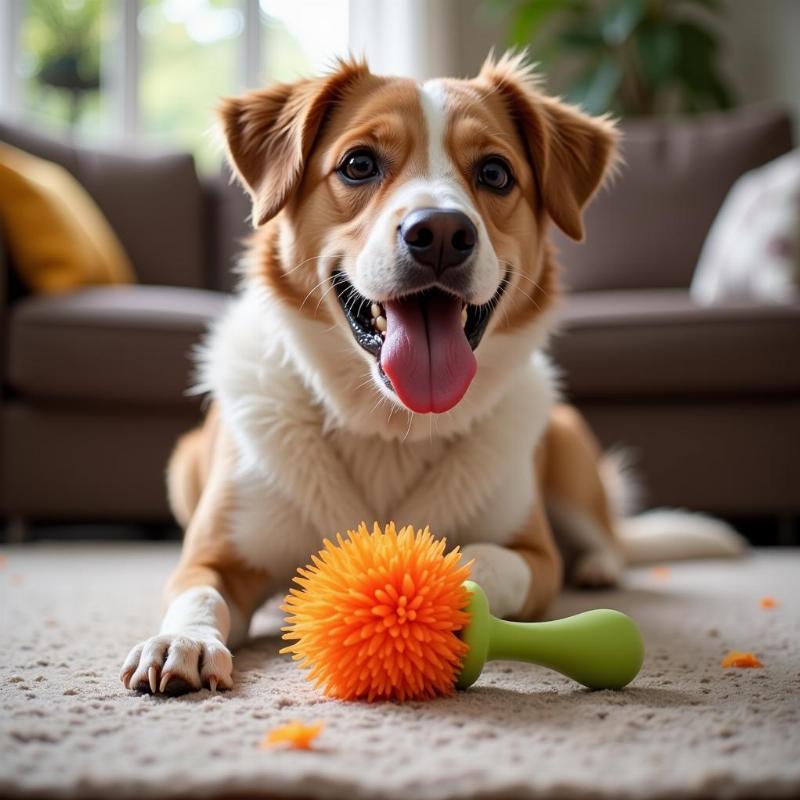Blindness doesn’t equate to a life of misery for a dog. In fact, dogs adapt remarkably well to vision loss, often thriving with the right care and environment. Can blind dogs be happy? Absolutely! They can experience joy, playfulness, and a strong bond with their owners, just like sighted dogs. Understanding the challenges and adjustments needed is key to ensuring a fulfilling life for your visually impaired companion.
Adapting to a World Without Sight: How Dogs Cope with Blindness
Dogs rely heavily on their senses of smell and hearing, and when sight diminishes, these other senses become even more heightened. This amazing adaptability allows them to navigate their surroundings, recognize familiar people and pets, and engage in playful activities. Think of it like switching from relying on a map to using GPS navigation – a different approach, but equally effective. They learn to memorize layouts, interpret sounds, and rely on their noses to build a mental map of their world.
Creating a Safe and Enriching Environment for Your Blind Dog
Consistency is key. Maintain a predictable environment by avoiding rearranging furniture or leaving objects in unexpected places. Verbal cues become crucial – use specific words for commands, praise, and warnings. Introduce “scent markers” like specific-smelling toys or rugs to help your dog identify different areas within the home. For example, a lavender-scented toy near the water bowl can signal its location.
Encouraging Play and Interaction: Keeping Your Blind Dog Engaged
Blind dogs can still enjoy a wide range of activities. Interactive games that stimulate their other senses are ideal. Think scent-based toys, puzzle feeders, and games like hide-and-seek with their favorite squeaky toy. Regular walks are important too, but opt for familiar routes and use a harness for better control and safety. Socialization with other dogs remains crucial, although supervised introductions and calm playdates are recommended.
 Blind Dog Playing with Scented Toy
Blind Dog Playing with Scented Toy
Common Concerns and Solutions for Blind Dog Owners
Many owners worry about their dog bumping into things. While some minor bumps are inevitable, creating a “blind dog-friendly” home minimizes risks. Padding sharp furniture corners, using baby gates to block off stairs, and keeping walkways clear can make a big difference. Anxiety can also be a concern. Maintain a calm and reassuring presence, offering plenty of affection and positive reinforcement. If anxiety becomes severe, consult a veterinarian or a certified dog behaviorist.
Recognizing the Signs of Blindness in Your Dog
Early detection is important. Look out for signs like cloudy eyes, bumping into objects, hesitancy in unfamiliar environments, or changes in behavior. If you notice any of these signs, schedule a veterinary appointment immediately. While some blindness is age-related or due to genetic conditions, other causes are treatable.
Living a Full Life: The Joy of a Blind Canine Companion
how to help a dog up the stairs
Don’t let the fear of blindness prevent you from experiencing the joy of having a blind dog in your life. With love, patience, and the right adjustments, blind dogs can live happy, fulfilling lives, bringing unconditional love and unwavering companionship to their families. They adapt, they thrive, and they remind us that true happiness transcends limitations.
Conclusion
Can blind dogs be happy? Absolutely! While blindness presents challenges, with the right care, environment, and understanding, blind dogs can lead rich and fulfilling lives. By focusing on their other senses, providing a safe and stimulating environment, and offering unwavering love and support, you can empower your blind canine companion to thrive and experience joy.
FAQ
- How do blind dogs navigate their surroundings? Blind dogs primarily rely on their heightened senses of smell and hearing to navigate. They learn to memorize their environment and interpret sounds to build a mental map.
- What kind of toys are best for blind dogs? Scent-based toys, puzzle feeders, and toys that make noise are excellent choices for engaging a blind dog’s other senses.
- Is it safe for blind dogs to play with other dogs? Yes, but supervised introductions and calm playdates are recommended to ensure safety and minimize stress.
- What are the signs of blindness in dogs? Cloudy eyes, bumping into objects, hesitancy in unfamiliar environments, and changes in behavior can all be signs of vision loss.
- What should I do if I think my dog is going blind? Schedule a veterinary appointment immediately for a proper diagnosis and to discuss treatment options.
- Can blind dogs still go for walks? Absolutely! Stick to familiar routes, use a harness for better control, and provide verbal cues to guide them.
- How can I make my home safer for a blind dog? Pad sharp furniture corners, use baby gates to block off stairs, and keep walkways clear of obstacles.
head protection for blind dogs
when to put a blind and deaf dog down
Beautdogs.us is your premier online resource for comprehensive and engaging information on dog breeds, care, and products specifically tailored for the US market. Whether you’re a seasoned dog owner or just starting your journey, Beautdogs.us offers expert advice and valuable resources to help you provide the best care for your canine companion. Contact us today for all your dog-related needs! Email: [email protected], Phone: +1 501-555-7529. Visit Beautdogs.us for more helpful tips and resources.